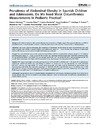Identificador persistente para citar o vincular este elemento:
https://accedacris.ulpgc.es/jspui/handle/10553/21071
| Título: | Prevalence of abdominal obesity in Spanish children and adolescents. do we need waist circumference measurements in pediatric practice? | Autores/as: | Schröder, H. Ribas-Barba, Lourdes Koebnick, C. Funtikova, A. Gómez, Santiago F. Fitó, Montse Pérez-Rodrigo, Carmen Serra-Majem, Lluis |
Clasificación UNESCO: | 3206 Ciencias de la nutrición | Palabras clave: | Obesity Children Adolescents Spain |
Fecha de publicación: | 2014 | Publicación seriada: | PLoS ONE | Resumen: | Background: Evidence indicates that central adiposity has increased to a higher degree than general adiposity in children and adolescents in recent decades. However, waist circumference is not a routine measurement in clinical practice. Objective: This study aimed to determine the prevalence of abdominal obesity based on waist circumferences (WC) and waist to height ratio (WHtR) in Spanish children and adolescents aged 6 to 17 years. Further, the prevalence of abdominal obesity (AO) among normal and overweight individuals was analyzed.Design: Data were obtained from a study conducted from 1998 to 2000 in a representative national sample of 1521 children and adolescents aged 6 to 17 years (50.0% female) in Spain. WC and WHtR measurements were obtained in addition to BMI. AO was defined as WHtR >= 0.50 (WHtR-AO), sex and age specific WC >= 90th percentile (WC-AO1), and sex and age specific WC cut-off values associated with high trunk fat measured by by dual-energy X-ray absorptiometry (WC-AO2).Results: IOTF-based overweight and obsity prevalence was 21.5% and 6.6% in children and 17.4% and 5.2% in adolescents, respectively. Abdominal obesity (AO) was defined as WHtR >= 0.50 (WHtR-AO), sex-and age-specific WC >= 90th percentile (WC-AO1), and sex- and age-specific WC cut-off values associated with high trunk fat measured by dual-energy X-ray absorptiometry (WC-AO2). The respective prevalence of WHtR-AO, WC-AO1, and WC-AO2 was 21.3% (24.6% boys; 17.9% girls), 9.4% (9.1% boys; 9.7% girls), and 26.8% (30.6% boys; 22.9% girls) in children and 14.3% (20.0% boys; 8.7% girls), 9.6% (9.8% boys; 9.5% girls), and 21.1% (28.8% boys; 13.7% girls) in adolescents.Conclusion: The prevalence of AO in Spanish children and adolescents is of concern. The high proportion of AO observed in young patients who are normal weight or overweight indicates a need to include waist circumference measurements in routine clinical practice. | URI: | https://accedacris.ulpgc.es/handle/10553/21071 | DOI: | 10.1371/journal.pone.0087549 | Fuente: | PLoS ONE [EISSN 1932-6203], v. 9 (1), (Enero 2014) | Derechos: | by-nc-nd |
| Colección: | Artículos |
Citas SCOPUSTM
110
actualizado el 08-jun-2025
Citas de WEB OF SCIENCETM
Citations
90
actualizado el 08-jun-2025
Visitas
97
actualizado el 31-oct-2024
Descargas
144
actualizado el 31-oct-2024
Google ScholarTM
Verifica
Altmetric
Comparte
Exporta metadatos
Los elementos en ULPGC accedaCRIS están protegidos por derechos de autor con todos los derechos reservados, a menos que se indique lo contrario.
